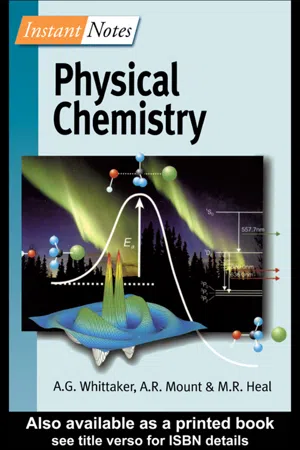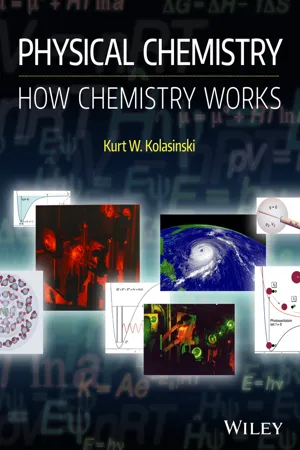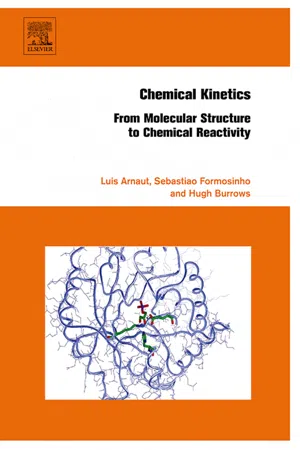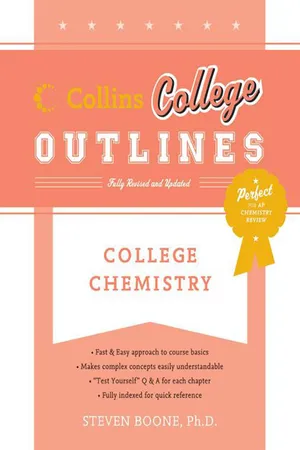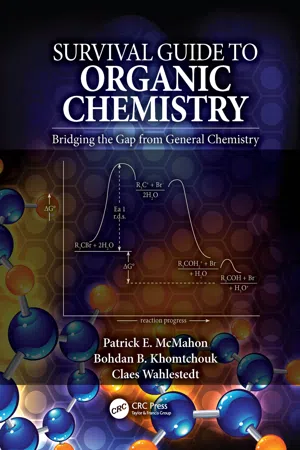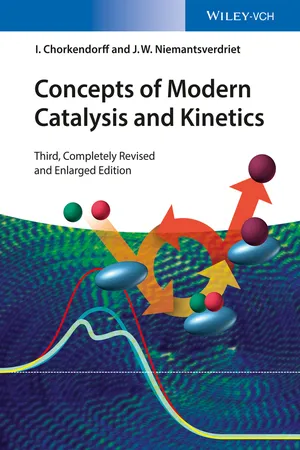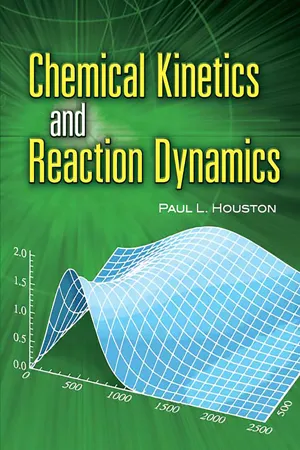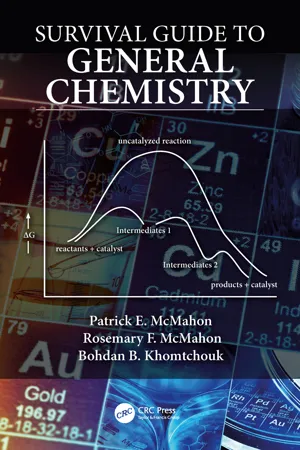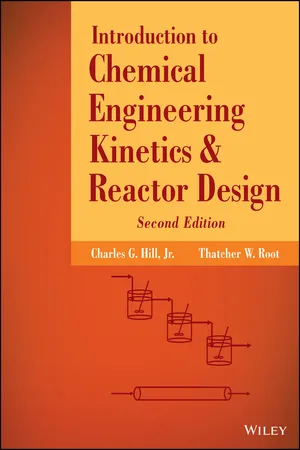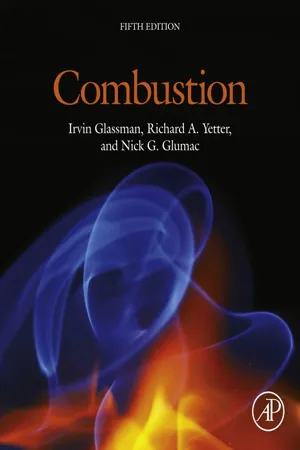Chemistry
Rate Law
Rate law in chemistry refers to the mathematical expression that relates the rate of a chemical reaction to the concentration of reactants. It is determined experimentally and provides insight into the reaction mechanism. The rate law equation is typically of the form rate = k[A]^m[B]^n, where k is the rate constant and m and n are the reaction orders with respect to the reactants A and B, respectively.
Written by Perlego with AI-assistance
Related key terms
Related key terms
1 of 4
Related key terms
1 of 3
11 Key excerpts on "Rate Law"
- eBook - ePub
- Gavin Whittaker, Andy Mount, Matthew Heal(Authors)
- 2000(Publication Date)
- Taylor & Francis(Publisher)
Fig. 3 The instantaneous rate of a reaction for a species is the slope of the tangent to the curve of concentration against time.Reactants and products may be consumed and formed at different rates according to the particular reaction stoichiometry (the numbers of molecules of reagent and products in the balanced chemical equation). For example, at any point in the reaction between hydrogen and nitrogen to form ammonia:the rate of consumption of hydrogen is three times the rate of consumption of nitrogen, whilst the rate of production of ammonia is twice the rate of consumption of nitrogen but only two-thirds the rate of consumption of hydrogen.Rate Law
The Rate Law is the empirical relationship which describes the observed rate of reaction in terms of the concentrations of species in the overall reaction, including possibly the concentration of the products.It is often observed that the rate of reaction is proportional to the product of the individual concentrations of the reactants raised to a simple power, for example, rate ∝[A]α [B]β. Rate Laws are empirical observations and do not necessarily fit the simple stoichiometry of the balanced chemical equation for the observed reaction but may be the consequence of a more complex underlying molecular reaction mechanism. For example, the apparently straightforward chemical reaction:has the experimentally determined Rate Law (see Topic F6 ):Rate constants
Rate constants , k , are the constants of proportionality which appear in the empirical Rate Law linking rate of reaction and concentration of species. The dimensions of the units of k are dependent on the formulation of the individual Rate Law but can always be derived by dimensional analysis of the Rate Law. Thus a reaction which is second order overall must have a rate constant with dimensions of concentration−1 .time−1 in order to provide the right hand side of the Rate Law with dimensions equal to the dimensions of concentrationtime1 for rate of reaction. The exact units of k depend on the units of concentration and time used, but mol dm−3 - eBook - ePub
Physical Chemistry
How Chemistry Works
- Kurt W. Kolasinski(Author)
- 2016(Publication Date)
- Wiley(Publisher)
CHAPTER 16 Empirical chemical kineticsPREVIEW OF IMPORTANT CONCEPTS
- A Rate Law relates concentration to time in terms of the concentrations of the species involved in the reaction. The differential form describes the rate of change of concentration with respect to time. The integrated form describes concentration as a function of time.
- We need to differentiate between elementary reactions (ones that occur in a single step) and composite reactions (ones that are composed of a series of elementary steps).
- For an elementary reaction, the kinetic order of reaction is always the same as the molecularity, the partial order with respect to a specific reactant is the same as its stoichiometric coefficient, and products do not appear in the rate equation.
- The kinetic order of a composite reaction is not directly related to the stoichiometry of the balanced chemical reaction.
- A reaction mechanism is a series of elementary reactions that adds up to the stoichiometry of the composite reaction.
- A rate-determining step is the elementary step in the reaction mechanism that has the greatest influence on the reaction rate.
- The rate constant is a positive number, the units of which depend on the reaction order. Many rate constants exhibit Arrhenius behavior, which means they have a temperature dependence given by the Arrhenius equation.
- Thermodynamics determines the concentrations of reactants and products at equilibrium. Kinetics describes the rate of evolution of a system. It determines how long it takes for a system to achieve equilibrium, if at all.
- Collisions almost invariably precede reaction, and the collision rate represents an upper limit to the rate at which a reaction can occur.
- Only collisions that have sufficient energy and which satisfy the proper geometry lead to reaction.
16.1 What is chemical kinetics?
Chemical kinetics is the measurement and description of the rates of chemical reactions. It seeks to develop mathematical equations that describe and predict the course of chemical reactions in terms of the species involved in the reaction. The mathematical equations are called Rate Laws - eBook - ePub
Reaction Kinetics
Homogeneous Gas Reactions
- Keith J. Laidler, Robert Robinson, H. M. N. H. Irving, L. A. K. Staveley(Authors)
- 2013(Publication Date)
- Pergamon(Publisher)
The subject of chemical kinetics is concerned with the rates of chemical reactions, and with the factors upon which the rates depend. The most important of these factors are concentration, temperature and hydrostatic pressure. By making systematic studies of the effects of these factors on rates it is possible to draw conclusions about the detailed mechanisms by which chemical reactions proceed. It is probably true to say that the ultimate objective of a kinetic study is to arrive at a reaction mechanism. Studies of a non-kinetic nature, such as stereochemical studies, may also provide valuable information as to mechanism, and must always be taken into account in a kinetic investigation.In any branch of science it is convenient to distinguish between the phenomenological, or empirical, laws that are obeyed, and the theories that are formulated in order to provide an explanation for these laws. The present chapter is mainly concerned with the kinetic laws, and with the analysis of experimental results in terms of simple concepts; it is almost entirely devoted to a consideration of the way in which rates depend on concentration. Chapter 2 , on the other hand, deals with the interpretation of rates in terms of more fundamental theories.RATE OF REACTION
The rate of a chemical reaction, which may also be referred to as its velocity or speed , may be expressed in various ways. In some investigations it is convenient to measure the concentration x of a product of reaction at various times, and curve a in Fig. 1 shows schematically how such a concentration may vary with the time. The slope dx /dt of such a curve at any time then provides a measure of the rate at that time. If the units of concentration are moles per litre the units of the rate are clearly moles litre−1 sec−1 .FIG. 1 Schematic curves showing the concentration of a product, and the concentration of a reactant, as functions of time.Alternatively, one may measure the concentration of a reactant, and curve b of Fig. 1 shows how such a concentration may vary with time. The slopes, dc /dt , are now all negative; it is convenient to drop the negative sign and define the rate as −dc /dt .It is important to note that the rate of a chemical reaction may have a different numerical value according to the way it is defined and measured. Consider, for example, the reaction - eBook - ePub
Chemical Kinetics
From Molecular Structure to Chemical Reactivity
- Luis Arnaut, Hugh Burrows(Authors)
- 2006(Publication Date)
- Elsevier Science(Publisher)
4Reaction Order and Rate Constants
Publisher Summary
This chapter discusses the Rate Laws for elementary reactions. The majority of kinetic processes involve more than one elementary step. The dependence of the rate of a chemical reaction upon the concentration of reactants is obtained experimentally. For any time instant, the reaction velocity can be calculated from the tangent to the curve of the variation of concentration of reactants or products as a function of time. Since the Rate Law may change during the course of a reaction, in principle this should be determined experimentally at various times of reaction, either to confirm that it is constant or to identify any changes. The determination of rates of reactions using this method of tangents is known as the differential method of determination of Rate Laws. Alternatively, descriptions of the time evolution of concentration can be obtained by mathematical integration of the kinetic laws rather than from the study of the variation of concentration with time. However, the fact that a mechanism is in agreement with the kinetic law does not mean that it is the correct mechanism for the reaction. The same kinetic law can, and frequently does, correspond to more than one possible mechanism. A mechanism is always a theoretical hypothesis of how a reaction occurs.4.1 RATES OF ELEMENTARY REACTIONS
The dependence of the rate of a chemical reaction upon the concentration of reactants must be obtained experimentally. For any time instant, the reaction velocity can be calculated from the tangent to the curve of the variation of concentration of reactants or products as a function of time. Since the Rate Law may change during the course of a reaction, in principle this should be determined experimentally at various times of reaction, either to confirm that it is constant or to identify any changes. However, although this is possible, such a procedure is very time consuming and is not normally used, except for the initial phase of the reaction. The determination of rates of reactions using this method of tangents is known as the differential method of determination of Rate Laws. - No longer available |Learn more
- Steven Boone, Drew H. Wolfe(Authors)
- 2011(Publication Date)
- Collins Reference(Publisher)
To obtain the dependence of concentration on reaction rate, the instantaneous rate is measured for different starting concentrations. The instantaneous rate is approximated by measuring a concentration change over a short time period at the very beginning of the reaction. From these data, the rate expression is derived. For example, if compound A decomposes to products, A → products, a rate expression with the following form is derived.In this rate expression, or Rate Law equation, k , is the rate constant, [A] is the molar concentration of A, and x is the reaction order. Because [A] decreases and the reaction rate is always positive, the sign is in the Rate Law equation.Reaction OrdersThe exponents of the concentration terms in the Rate Law are termed the reaction orders. When the molar concentration of A is raised to the first power, the reaction is said to be first order with respect to A. If the molar concentration of A is raised to the second power, the reaction is said to be second order with respect to A. If a reactant is first order, when its molar concentration doubles, the initial instantaneous rate doubles. If the concentration triples, the reaction rate triples.Instantaneous rate ∞ [A]1However, if the reaction order with respect to the reactant is second order, the reaction rate increases four times, 22 , when the concentration doubles and increases eight times, 23 , when the concentration triples.Instantaneous rate ∞ [A]2Overall Reaction OrdersFor reactions that have more than one reactant, the sum of the reaction orders in the Rate Law equals the overall reaction order. For example, consider the following rate expression for the reaction, A + B → products.The overall reaction order equals is the sum of the exponents, x + y . Thus, if x = 1 and y = 2, the overall reaction order equals 3, which is a third-order reaction. This means if the molar concentrations of both reactants doubles, the rate of the reaction increases eight times, 21 × 22 23 - eBook - ePub
Survival Guide to Organic Chemistry
Bridging the Gap from General Chemistry
- Patrick E. McMahon, Bohdan B. Khomtchouk, Claes Wahlestedt(Authors)
- 2016(Publication Date)
- CRC Press(Publisher)
rate expression or Rate Law:rate( r )= k[xreactant 1][reactant 2]y… .- The constant in the expression is called the rate constant, k; the numerical values of the exponents x, y, etc. are called the reactant orders . For example, if x = 2 in the above general expression, the reaction is “second-order in reactant 1.”
- The sum of all the exponents x + y ... is called the reaction order . For example, if x = 2 and y = 1 in the above general expression, the reaction would be described as a “third-order reaction.”
- The values of k, x, y ... depend on the mechanistic steps .
9.1.3 ADDITIONAL VARIABLES AFFECTING REACTION RATES
- Rates are inversely proportional to the energy barriers that prevent a specific reaction step from occurring; this barrier is called the activation energy , or activation barrier for this step (general symbol: Ea ).
- The activation energy, Ea , represents the energy that must be added to reactants to allow bonding changes to occur.
- A reaction rate will increase as the activation energy (barrier) decreases. Ea is a path function and does not depend directly on ΔG for the complete reaction. The specific Ea, most important for a complete reaction containing many steps, depends on the mechanism.
- eBook - ePub
- I. Chorkendorff, J. W. Niemantsverdriet(Authors)
- 2017(Publication Date)
- Wiley-VCH(Publisher)
ab initio theoretical chemistry, and transition state theory. It is at this level that we can learn what determines whether a chemical reaction is feasible.In practical situations, we are not interested in the single event but in what happens in a large ensemble of molecules. We therefore have to average over all possibilities, that is, over all energies and coordinates of the reacting molecules. This is what kinetics is about. Temperature is the parameter that suitably describes the average energy content of the molecules participating in the reaction. Thermodynamics determines the changes in free energy that accompany a reaction and sets limits to the fraction of molecules that can be converted. Thus, kinetics describes the behavior of large ensembles of molecules during a reaction.2.2 The Rate Equation and Power Rate Laws
Suppose a reaction between molecules A and B gives product molecules C and D according to the reaction equation(2.1)with forward and backward rate constants, k+ and k− , and stoichiometric coefficients νa , νb , νc , and νd . The rate of reaction is defined as the rate of disappearance of the reactants, or the rate of formation of products:(2.2)where [X] stands for the concentration of component X. If the reaction occurs in the gas phase, we may replace the concentrations by partial pressures: [X] ∝ pX /p◦ , where p◦ is the reference pressure (p◦ = 1 bar).(2.3)Very often, we will not include the reference pressure, p◦ , but implicitly assume that p represents a relative quantity.A reaction is elementary if it occurs in a single step that cannot be divided into any further substeps and proceeds exactly as expressed by the reaction equation (Eq. (2.1) ). For an elementary step, the rate equals(2.4)in which k+ and k− - eBook - ePub
- Paul L. Houston(Author)
- 2012(Publication Date)
- Dover Publications(Publisher)
rate-limiting step. The Rate Law then contains in its numerator the rate of this rate-limiting step.The second concept is one that we have already encountered. When the rates of steps in the mechanism are comparable, it is still usually possible to assume that the concentration of reaction intermediates is low and varies slowly. This is just the steady-state hypothesis of Section 2.4.3.Even with a few principles in hand, it is ultimately experience that provides the best guide to guessing mechanisms from overall Rate Laws. Fortunately, we already have some experience. Let us look back at the systems we have studied to see if we can determine how we might apply the two basic concepts to obtain clues for determining a plausible mechanism from the overall Rate Law.We start our excursion with the rate-law result of the Lindemann mechanism for the overall reaction A → products:(2.117)One obvious clue to this reaction is that the Rate Law depends on something other than the reactants or products, namely, the overall pressure of the gas mixture and not just the partial pressure of the reactant. Another clue comes in the complex form of the denominator. Recall that a mechanism that leads to this Rate Law is(2.118)The complex form of the denominator comes from the fact that the intermediate in this reaction can disappear in two possible ways. Thus, we have already developed two clues: (1) complex denominators likely indicate that an intermediate in steady-state can disappear in more than one way and (2) the presence of something other than a reactant or product in the numerator (or, as it also turns out, in the denominator) likely indicates that an equilibrium step appears in the mechanism. - eBook - ePub
- Patrick E. McMahon, Rosemary McMahon, Bohdan Khomtchouk(Authors)
- 2019(Publication Date)
- CRC Press(Publisher)
reaction step rate rule:Rule 1: The rate of any elementary reaction step is proportional to the concentrations of each reactant species involved in that step, raised to the power of the number of molecules of the specific reactant involved in that reaction step. This power will equal the reactant coefficient in the specific reaction step balanced chemical equation.The rule applies only to reaction steps, not to general balanced equations. Rate expressions for multi-step reactions cannot be analyzed by applying Rule 1 to the balanced equation. Multi-step reactions must be derived from elementary step rate expressions and the additional rules given in the next section.Example: Apply Rule 1 to the following proposed elementary reaction steps:A + B + C→ABC rate of the step=k[A][B][C]NO 2+NO 2→N 2O 4rate of the step=k[NO 2] 22 C +O 2→2 CO rate of the step=k[C] 2[O 2]CH 4+ Cl→CH 3+ HCl rate of the step=k [CH 4][Cl]Rule 2: If the complete reaction mechanism consists of only one (elementary) step, then the rate expression for the overall (complete) reaction is identical to the rate expression for the single step that describes the mechanism. In this case, the reaction step rate rule is used directly; nothing else is required.Rate expressions for multiple-step mechanisms cannot be predicted directly from the reaction step rate rule: the rule applies only to reaction steps, not to general balanced equations.Example: The balanced equation for the synthesis of ammonia is shown.N 2+ 3H 2→2NH 3Experiments have determined that this is a multi-step reaction; this could not be inferred simply from the equation. A multi-step reaction implies that the rule cannot be used directly: rate (overall) is not equal to k [N2 ] [H2 ]3 - Charles G. Hill, Thatcher W. Root(Authors)
- 2014(Publication Date)
- Wiley(Publisher)
In addition to spectrophotometric or spectroscopic measurements, there are a number of other optical measurements that can be used to monitor the course of various reactions. Among the optical properties that can be used for these studies are optical rotation, refractive indices, fluorescence, and colorimetry. There also are several electrical measurements that may be used for analysis of solutions under in situ conditions. Among the properties that may be measured are dielectric constants, electrical conductivity or resistivity, and the redox potential of solutions. These properties are easily measured with instrumentation that is readily interfaced to a computer for data acquisition and manipulation for analysis. However, most of these techniques should be used only after careful calibration and do not give better than 1% accuracy without unusual care in the experimental work.3.3 Techniques for the Interpretation of Kinetic Data
In Section 3.1 the mathematical expressions that result from integration of various reaction rate functions were discussed in some detail. Our present problem is the converse of that considered earlier (i.e., given data on the concentration of a reactant or product as a function of time, how does one proceed to determine the reaction rate expression?).Determination of the rate expression normally involves a two-step procedure. First, the concentration dependence is determined at a fixed temperature. Then the temperature dependence of the rate constants is evaluated to obtain a complete reaction rate expression. The form of this temperature dependence is given by equation (3.0.14), so our present problem reduces to that of determining the form of the concentration dependence and the value of the rate constant at the temperature of the experiment.Unfortunately, there is no completely general method of determining the reaction rate expression or even of determining the order of a reaction. Usually, one employs an iterative trial-and-error procedure based on intelligent guesses and past experience with similar systems. Very often the stoichiometry of the reaction and knowledge of whether the reaction is “reversible” or “irreversible” will suggest a form of the rate equation to try first. If this initial guess (hypothesis) is incorrect, the investigator may then try other forms that are suggested either by assumptions about the mechanism of the reaction or by the nature of the discrepancies between the data and the mathematical model employed in a previous trial. Each reaction presents a unique problem, and success in fitting a reaction rate expression to the experimental data depends on the ingenuity of the individual investigator.- eBook - ePub
- Irvin Glassman, Richard A. Yetter, Nick G. Glumac(Authors)
- 2014(Publication Date)
- Academic Press(Publisher)
Chapter 2Chemical kinetics
Abstract
Chemical reaction types, reaction orders, and the law of mass action that describes the rates of reactions are presented. The Arrhenius rate constant expression and methods for analysis of rate constants, including transition state and recombination rate theories, are discussed as well as the effects of pressure and temperature. Chain reactions are introduced, and steady-state and partial equilibrium approximations are applied for their analysis. The mathematical formalism for large reaction mechanisms is illustrated through the development of the governing equations for coupled thermal and chemical reacting systems without mass diffusion. Finally, sensitivity and rate-of-production analyses are discussed for mechanism analysis as well as methods for mechanism reduction.Keywords
Arrhenius rate constant; Chemical reactions; Partial equilibrium and steady-state assumptions; Pressure-dependent reactions; Rate-of-production analysis; Reaction rates; Sensitivity analysis; Transition state theory2.1. Introduction
Flames will propagate through only those chemical mixtures that are capable of reacting quickly enough to be considered explosive. Indeed, the expression “explosive” essentially specifies very rapid reaction. From the standpoint of combustion, the interest in chemical kinetic phenomena has generally focused on the conditions under which chemical systems undergo explosive reaction. Recently, however, great interest has developed in the rates and mechanisms of steady (nonexplosive) chemical reactions, since most of the known complex pollutants form in zones of steady, usually lower-temperature, reactions during, and even after, the combustion process. These essential features of chemical kinetics, which occur frequently in combustion phenomena, are reviewed in this chapter. For a more detailed understanding of any of these aspects and a thorough coverage of the subject, refer to any of the books on pure chemical kinetics, such as those listed in Refs [1 ,2
Index pages curate the most relevant extracts from our library of academic textbooks. They’ve been created using an in-house natural language model (NLM), each adding context and meaning to key research topics.
Explore more topic indexes
Explore more topic indexes
1 of 6
Explore more topic indexes
1 of 4
